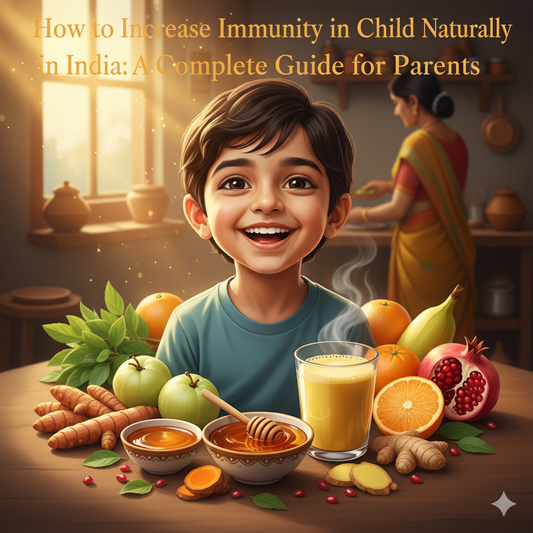
How to Increase Immunity in Kids: Natural Indian Home Remedies
Introduction: More Than Just Clothing - We Care About Your Child's Health
At our kids clothing brand based in Tiruppur, India, we're not just manufacturers creating comfortable, quality garments for your little ones. Yes, we're a wholesale kids clothing supplier with low MOQ, serving retailers across the country through Myntra, Amazon, and our own website. But beyond the business of making clothes, we're parents too. We understand the sleepless nights when your child has a fever, the worry when they catch yet another cold, and the constant concern about keeping them healthy and strong.
That's why we regularly share parenting insights alongside our clothing collections. Because at the end of the day, what good is a beautiful outfit if your child isn't healthy enough to enjoy wearing it? Today, we're diving deep into a topic that concerns every Indian parent, especially during the challenging winter months: how to boost your child's immunity naturally using time-tested Indian home remedies.
The Winter Challenge: Why Kids Fall Sick More Often
As the temperature drops and winter sets in across India, pediatric clinics overflow with sick children. It's not your imagination - kids genuinely do fall sick more frequently during colder months. The reasons are scientific and straightforward:
Viruses thrive in cold weather. Common culprits like rhinovirus (causing common cold), influenza virus, respiratory syncytial virus (RSV), and adenovirus become more active and survive longer in cold, dry air. These pathogens spread rapidly in enclosed spaces where children gather - schools, play areas, and homes with closed windows.
Indoor crowding increases transmission. During winters, we keep windows closed and spend more time indoors in close proximity, creating perfect conditions for viruses to jump from person to person. When one child in a classroom sneezes, the entire class becomes vulnerable.
Dry air weakens natural defenses. Our nasal passages and respiratory tract have mucous membranes that trap viruses and bacteria. Cold, dry winter air dries out these membranes, making them less effective barriers against infections.
Less sunlight means less Vitamin D. Shorter days and more time indoors reduce sun exposure, leading to Vitamin D deficiency. This crucial vitamin plays a significant role in immune function.
Children's immune systems are still developing. Kids haven't yet built immunity to the hundreds of viruses circulating around them, making them more susceptible than adults.
The question isn't whether your child will catch infections - it's how we can strengthen their immunity to fight off these infections more effectively and recover faster.
The Indian Advantage: Centuries of Immunity Wisdom
India's traditional medicine systems - Ayurveda, home remedies passed down through generations, and dietary wisdom - offer powerful, natural ways to boost children's immunity. Our grandmothers knew what modern science is now confirming: food is medicine, and prevention is better than cure.
Powerful Indian Home Remedies to Boost Immunity
1. Haldi Doodh (Turmeric Milk) - The Golden Immunity Potion
Turmeric contains curcumin, a powerful anti-inflammatory and antioxidant compound. A warm cup of haldi doodh before bedtime works wonders:
Recipe: Boil a cup of milk with half a teaspoon of turmeric powder, a pinch of black pepper (enhances curcumin absorption), and a little honey or jaggery for sweetness. Give this to children above one year, 3-4 times a week.
Benefits: Fights infections, reduces inflammation, promotes better sleep, and strengthens the immune response.
2. Tulsi (Holy Basil) - Nature's Antibiotic
Tulsi has been revered in Indian households for its medicinal properties. It's antibacterial, antiviral, and immune-boosting.
How to use:
- Add 5-6 fresh tulsi leaves to your child's morning tea (for older kids)
- Make tulsi kadha by boiling tulsi leaves with ginger and honey
- Give tulsi drops (available commercially) - 2-3 drops twice daily for younger children
- Simply have your child chew 2-3 fresh tulsi leaves every morning
Benefits: Fights respiratory infections, reduces fever, clears congestion, and boosts overall immunity.
3. Ghee - The Forgotten Superfood
Pure desi cow ghee is packed with fat-soluble vitamins A, D, E, and K, all crucial for immunity.
How to use:
- Add a teaspoon of ghee to your child's dal, rice, or roti daily
- Give a spoonful of ghee with warm milk at bedtime
- Use ghee for cooking instead of refined oils
Benefits: Improves gut health (where 70% of immunity resides), provides healthy fats for brain development, and helps absorb vital nutrients.
4. Ginger-Honey Mix - The Dynamic Duo
This combination is powerful against colds, coughs, and throat infections.
Recipe: Mix fresh ginger juice (1 teaspoon) with raw honey (1 teaspoon). Give this mixture 2-3 times daily, especially during the onset of cold symptoms. (Only for children above 1 year due to honey)
Benefits: Ginger has anti-inflammatory properties and improves digestion, while honey is antibacterial and soothes the throat.
5. Chyawanprash - The Ancient Immunity Booster
This Ayurvedic formulation contains over 40 herbs, with amla (Indian gooseberry) as the base. It's been used for centuries to build immunity.
How to use: Give one teaspoon with warm milk or water every morning. Children usually love its sweet-tangy taste.
Benefits: Rich in Vitamin C, antioxidants, and immune-boosting herbs. Helps fight infections and increases stamina.
6. Ajwain (Carom Seeds) - For Digestive and Respiratory Health
Ajwain is excellent for both prevention and treatment of respiratory issues.
How to use:
- Boil ajwain in water, strain, and give the warm water for coughs and colds
- Dry roast ajwain and tie in a cloth as a potli; let your child inhale the aroma to clear congestion
- Add ajwain to parathas or khichdi
Benefits: Relieves congestion, improves digestion, and has antimicrobial properties.
7. Amla (Indian Gooseberry) - Vitamin C Powerhouse
Amla contains 20 times more Vitamin C than oranges and is one of the richest natural sources of this immunity-boosting vitamin.
How to use:
- Fresh amla juice (1 teaspoon) with honey daily
- Amla murabba (preserve) - one piece daily
- Amla powder mixed in water
- Amla candy as a healthy snack
Benefits: Strengthens immunity, improves digestion, and protects against infections.
8. Desi Ghee Nasya - Nasal Protection
Applying a small amount of warm ghee inside nostrils creates a protective barrier against airborne viruses.
How to use: Use a clean cotton swab to apply a tiny amount of lukewarm ghee inside each nostril before your child goes to school or outdoor activities during winter.
Benefits: Prevents dryness, traps pathogens before they enter the system, and protects nasal membranes.
9. Gud (Jaggery) - The Winter Essential
Jaggery generates heat in the body and is packed with minerals.
How to use:
- Replace sugar with jaggery in milk, tea, or desserts
- Give a small piece of jaggery with ghee after meals
- Make gud-til (sesame-jaggery) ladoos during winter
Benefits: Boosts immunity, keeps the body warm, aids digestion, and purifies blood.
10. Masala Doodh (Spiced Milk)
A warming, immunity-boosting drink perfect for winter nights.
Recipe: Boil milk with cinnamon stick, cardamom, a few strands of saffron, and a pinch of nutmeg. Add honey when slightly cooled.
Benefits: Multiple spices provide antioxidants, warmth, and immune support while making milk more appealing to kids.
How to Dress Kids in Winter to Prevent Cold
As kids clothing manufacturers, this is where our expertise truly shines. Proper winter dressing is your first line of defense against cold-related illnesses. Many parents make the mistake of either over-bundling or under-dressing their children. Here's how to get it right:
The Layering Principle
Layer 1 - Base Layer (Inner Wear): Start with soft, breathable cotton or cotton-blend thermal innerwear. This layer should fit snugly but comfortably against the skin, wicking away moisture while providing warmth. Avoid synthetic materials directly on skin as they can cause irritation and don't breathe well.
Layer 2 - Middle Layer (Insulation): Add a full-sleeved t-shirt or light sweater. This layer traps warm air and provides insulation. Fleece or wool blends work excellently for this purpose. Choose slightly loose-fitting garments to allow air circulation between layers.
Layer 3 - Outer Layer (Protection): Finish with a jacket, hoodie, or heavy sweater depending on the outdoor temperature. For very cold days or windy conditions, a windproof jacket is essential. The outer layer should protect against wind and light rain while allowing the child to move freely.
Don't Forget the Extremities
Head covering: Nearly 30% of body heat escapes through the head. A soft woolen cap or beanie is essential when going outdoors. Choose ones that cover the ears without being too tight.
Neck protection: A soft cotton or woolen muffler protects the throat and chest from cold air. This is particularly important for children prone to throat infections and coughs.
Hand protection: Mittens or gloves keep little hands warm. Mittens are warmer as fingers share heat, while gloves offer more dexterity for older kids.
Feet warmth: Cotton socks are good for indoors, but switch to wool-blend socks for outdoor activities. Ensure shoes aren't too tight when wearing thicker socks, as this restricts blood circulation and actually makes feet colder.
Smart Dressing Tips
Avoid overdressing indoors: Many Indian parents keep children heavily bundled even inside heated homes or schools. This causes sweating, and when children go outdoors, the moisture on their skin makes them more susceptible to catching cold. Dress appropriately for indoor temperatures.
Easy on-and-off: Choose clothing with simple closures like zippers over complicated buttons for younger children. They should be able to remove layers independently when they feel warm.
Breathable fabrics: Even in winter, choose breathable natural fabrics like cotton, wool, and their blends. Synthetic materials trap moisture and don't regulate temperature well.
Check for comfort: Ensure clothes aren't too tight around the neck, wrists, or waist. Tight clothing restricts blood flow and can make children feel colder.
Night dressing: For sleeping, avoid heavy blankets that children might kick off, leaving them exposed to cold. Instead, dress them in comfortable full-sleeved pajamas with socks. A sleep sack for younger children works wonderfully.
School considerations: Since schools may have varying indoor temperatures, dress children in layers they can easily remove. Send an extra sweater in the school bag for flexibility.
Common Winter Dressing Mistakes to Avoid
Mistake 1: Dressing children in the same thickness of clothing all day. Temperature varies significantly between morning, afternoon, and evening. Adjust layers accordingly.
Mistake 2: Keeping wet clothes on. If your child sweats during play or gets caught in rain, change their clothes immediately. Damp clothing against skin rapidly lowers body temperature.
Mistake 3: Ignoring fabric quality. Cheap synthetic fabrics may seem warm but often cause discomfort, sweating, and skin irritation. Invest in good quality cotton and wool blends.
Mistake 4: Same dressing for all ages. Babies and toddlers need more layers than older children as they're less active and can't regulate body temperature as efficiently.
Mistake 5: Forgetting about school activities. If your child has sports or outdoor activities at school, pack an extra set of warm clothes to change into afterward.
Regional Variations in India
North India (Delhi, Punjab, Himachal): Temperatures can drop significantly. Three-layer dressing with heavy woolens, caps, and mufflers is essential. Thermal wear is highly recommended.
South India (Tamil Nadu, Kerala, Karnataka): Winters are milder. Light woolens, full-sleeved cotton tops, and a light jacket for mornings and evenings usually suffice. Overdressing can cause discomfort.
East India (West Bengal, Odisha): Moderate cold with high humidity. Two-layer dressing with breathable fabrics works best. Protect against morning fog and evening chill.
West India (Maharashtra, Gujarat): Variable temperatures. Layering is key so children can adjust throughout the day. Light to medium woolens depending on the specific region.
Dietary Habits for Strong Immunity
Beyond specific remedies, overall dietary patterns matter immensely:
Include seasonal fruits and vegetables: Winter brings immunity-boosting produce like oranges, sweet lime, guava, carrots, beetroot, and green leafy vegetables. Make them regular parts of meals.
Serve warm, freshly cooked food: Ayurveda emphasizes warm, fresh meals over cold or reheated food, especially in winter. Hot khichdi, soups, and dal are easier to digest and provide warmth.
Don't skip breakfast: A nutritious breakfast kickstarts metabolism and provides energy for the day. Include protein (eggs, paneer, dal), whole grains (whole wheat, oats), and fruits.
Limit refined sugar and processed foods: These suppress immunity and provide empty calories. Replace chips and cookies with nuts, fruits, and homemade snacks.
Ensure adequate protein: Growing children need protein for antibody production. Include dal, eggs, chicken, fish, paneer, and curd daily.
Probiotics for gut health: Homemade curd, buttermilk, and fermented foods like idli and dosa support gut bacteria, which are crucial for immunity.
Lifestyle Practices That Boost Immunity
Adequate sleep: Children need 10-12 hours of sleep. During sleep, the body produces infection-fighting cytokines. Maintain consistent bedtime routines.
Regular physical activity: Outdoor play, running, cycling, or any physical activity improves circulation and immune function. Aim for at least 60 minutes daily.
Hygiene habits: Teach proper handwashing, especially before meals and after coming home from outside. This simple practice prevents most infections.
Sunlight exposure: Even 15-20 minutes of morning sunlight helps produce Vitamin D naturally. Let children play outdoors in winter mornings.
Stress reduction: Yes, even kids experience stress from academics and schedules. Ensure they have downtime, play, and family bonding to keep stress low.
Adequate hydration: Children often drink less water in winter. Ensure they drink enough fluids through water, soups, and warm beverages.
When to Consult a Doctor
While home remedies are powerful, they're not substitutes for medical care. Consult a pediatrician if:
- Fever persists beyond 3 days or exceeds 104°F
- Breathing difficulties occur
- Your child becomes unusually lethargic or unresponsive
- Symptoms worsen despite home treatment
- There's severe dehydration or inability to keep food down
Conclusion: Building Immunity is a Holistic Journey
As manufacturers of comfortable kids clothing, we know that physical comfort matters tremendously. But true well-being goes beyond what children wear - it's about what they eat, how they live, and the care they receive. That said, proper winter dressing combined with immunity-boosting home remedies creates a powerful shield against winter illnesses.
Building strong immunity isn't about a single magic remedy; it's about consistent, holistic practices. The Indian home remedies we've shared are gentle, effective, and time-tested. They work best when combined with appropriate clothing, nutritious food, adequate sleep, physical activity, and a stress-free environment.
This winter, as you dress your little ones in warm, cozy layers from our collection, also nourish them from within using these traditional remedies. Proper layering keeps their bodies warm and prevents cold exposure, while herbs and home remedies strengthen their internal defenses. Your grandmother's wisdom combined with modern understanding creates the perfect recipe for healthy, happy children who can fight off winter viruses and thrive.
Remember, a strong immune system isn't built overnight - it's cultivated day by day, meal by meal, layer by layer, and remedy by remedy. Start today, stay consistent, and watch your children grow stronger and healthier. Dress them right, feed them well, and let them play - that's the secret to a healthy winter.








